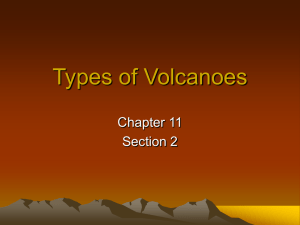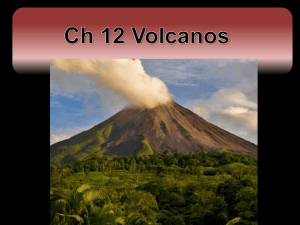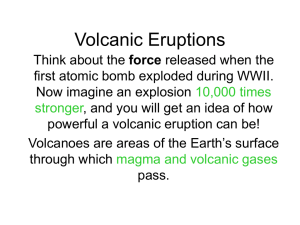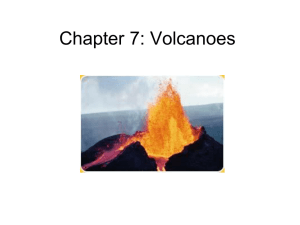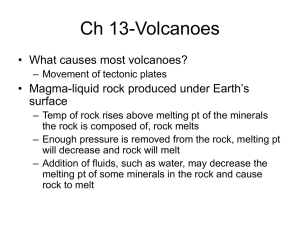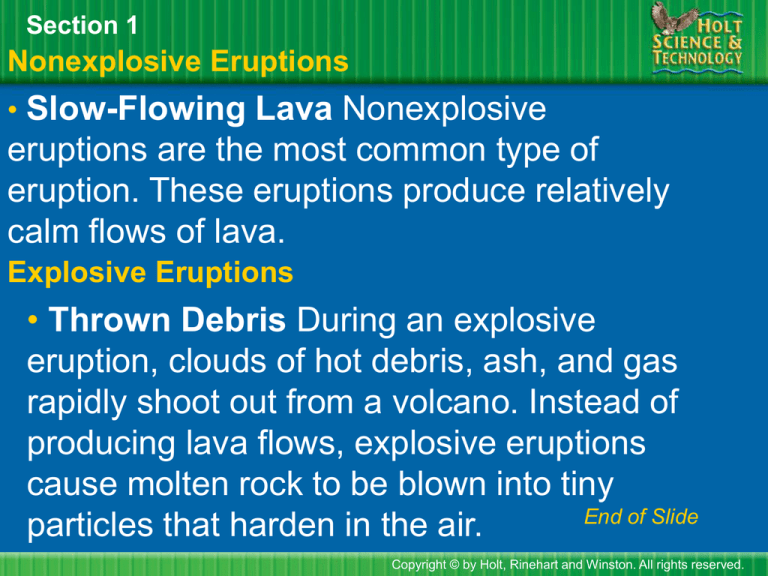
Section 1
Nonexplosive Eruptions
• Slow-Flowing Lava Nonexplosive
eruptions are the most common type of
eruption. These eruptions produce relatively
calm flows of lava.
Explosive Eruptions
• Thrown Debris During an explosive
eruption, clouds of hot debris, ash, and gas
rapidly shoot out from a volcano. Instead of
producing lava flows, explosive eruptions
cause molten rock to be blown into tiny
End of Slide
particles that harden in the air.
Copyright © by Holt, Rinehart and Winston. All rights reserved.
Section 1
Volcanic Eruptions
What Is Inside a Volcano?
• Magma Chamber A magma chamber
is a body of molten rock deep
underground that feeds a volcano.
Magma rises from the magma chamber
through cracks in the Earth’s crust to
openings called vents.
End of Slide
Copyright © by Holt, Rinehart and Winston. All rights reserved.
Section 1
Volcanic Eruptions
What Makes Up Magma?
• Water and Magma Are an Explosive
Combination If the water content of
magma is high, an explosive eruption is
more likely.
• Silica-Rich Magma Traps Explosive
Gases Magma that has a high silica
content also tends to cause explosive
End of Slide
eruptions.
Copyright © by Holt, Rinehart and Winston. All rights reserved.
Section 1
What Erupts from a Volcano?
• Types of Lava The viscosity of lava, or how lava
flows, varies greatly. The next slide shows four
different types of lava.
• Types of Pyroclastic Material Pyroclastic
material forms when magma explodes from a
volcano and solidifies in the air. The size of
pyroclastic material ranges from boulders that are
the size of houses to tiny particles.
• Pyroclastic Flows Pyroclastic flows are
produced when enormous amounts of hot ash,
dust, and gases are ejected from a volcano.End of Slide
Copyright © by Holt, Rinehart and Winston. All rights reserved.
Section 1
Four Types of Lava
Copyright © by Holt, Rinehart and Winston. All rights reserved.
Section 2
Effects of Volcanic Eruptions
Science Journal Entry
Look through this section, and write a definition for the
following terms: shield volcano, cinder cone volcano,
composite volcano, volcanic crater, and caldera.
Record your definitions in your science journal.
Copyright © by Holt, Rinehart and Winston. All rights reserved.
Section 2
Effects of Volcanic Eruptions
Volcanic Eruptions and Climate Change
• Change in Temperature As volcanic
ash and gases spread throughout the
atmosphere, they can block enough
sunlight to cause global temperatures
to drop. Such a change in temperature
can disrupt climates all over the world.
End of Slide
Copyright © by Holt, Rinehart and Winston. All rights reserved.
Section 2
Different Types of Volcanoes
• Shield Volcanoes Shield volcanoes are built of
layers of lava released from repeated
nonexplosive eruptions.
• Cinder Cone Volcanoes Cinder cone volcanoes
are made of pyroclastic material usually produced
from moderately explosive eruptions.
• Composite Volcanoes Composite volcanoes,
sometimes called stratovolcanoes, are one of the
most common types of volcanoes. They form from
explosive eruptions of pyroclastic material followed
End of Slide
by quieter flows of lava.
Copyright © by Holt, Rinehart and Winston. All rights reserved.
Section 2
Effects of Volcanic Eruptions
Other Types of Volcanic Landforms
• Craters Around the central vent at the top of many
volcanoes is a funnel-shaped pit called a crater.
• Calderas A caldera is a large, semicircular depression
that forms when the chamber that supplies magma to a
volcano partially empties and the chamber’s roof collapses.
The formation of a caldera is illustrated on the next slide.
• Lava Plateaus A landform that results from repeated
eruptions of lava spread over a large area is called a lava
plateau.
End of Slide
Copyright © by Holt, Rinehart and Winston. All rights reserved.
Section 2
The Formation of a Caldera
Copyright © by Holt, Rinehart and Winston. All rights reserved.
Section 3
Causes of Volcanic Eruptions
Science Journal Entry
Imagine you live on a volcanic island. List the signals that
would tell you the volcano was about to erupt.
Record your responses in your science journal.
Copyright © by Holt, Rinehart and Winston. All rights reserved.
Section 3
Causes of Volcanic Eruptions
The Formation of Magma
• Pressure and Temperature Rock melts when its
temperature increases or when the pressure on the rock
decreases.
• Magma Formation in the Mantle Because the
temperature of the mantle is fairly constant, a decrease in
pressure is the most common cause of magma formation.
End of Slide
Copyright © by Holt, Rinehart and Winston. All rights reserved.
Section 3
Causes of Volcanic Eruptions
Where Volcanoes Form
• Location The locations of volcanoes give clues about
how volcanoes form. The next slide shows the locations of
major volcanoes around the world.
• Plate Boundaries About 80% of active volcanoes on land
form where plates collide, and about 15% form where
plates separate.
End of Slide
Copyright © by Holt, Rinehart and Winston. All rights reserved.
Section 3
The Location of Major Volcanoes
Copyright © by Holt, Rinehart and Winston. All rights reserved.
Section 3
Causes of Volcanic Eruptions
When Tectonic Plates Separate
• Divergent Boundaries At a divergent boundary, tectonic
plates move away from each other.
• Mid-Ocean Ridges Form at Divergent Boundaries Most
volcanic activity on Earth occurs at mid-ocean ridges. The
next slide shows how magma forms at divergent
boundaries such as those found along mid-ocean ridges.
End of Slide
Copyright © by Holt, Rinehart and Winston. All rights reserved.
Section 3
How Magma Forms at a Divergent Boundary
Copyright © by Holt, Rinehart and Winston. All rights reserved.
Section 3
Causes of Volcanic Eruptions
When Tectonic Plates Collide
• Convergent Boundary A convergent boundary is a place
where tectonic plates collide.
• Subduction Produces Magma As the descending
oceanic crust scrapes past the continental crust, the
temperature and pressure increase. This causes the water
contained in the oceanic crust to be released. The water
mixes with the mantle rock, which lowers the rock’s melting
point, causing it to melt into magma. This process is
illustrated on the next slide.
End of Slide
Copyright © by Holt, Rinehart and Winston. All rights reserved.
Section 3
How Magma Forms at a Convergent Boundary
Copyright © by Holt, Rinehart and Winston. All rights reserved.
Section 3
Causes of Volcanic Eruptions
Hot Spots
• What Are Hot Spots? Hot spots are volcanically active
places on the Earth’s surface that are far from plate
boundaries.
• What Do Hot Spots Form? A hot spot often produces a
long chain of volcanoes.
•How do hot spots Form? A hot spot forms from Mantle
Plumes, or areas of the mantle that are hotter then others
End of Slide
Copyright © by Holt, Rinehart and Winston. All rights reserved.
Section 3
Causes of Volcanic Eruptions
Predicting Volcanic Eruptions
• Measuring Small Quakes and Volcanic Gases Most
active volcanoes produce small earthquakes as the magma
within them moves upward. Also the ratio of certain gases
may be important in predicting eruptions.
• Measuring Slope and Temperature As magma moves
upward prior to an eruption, it can cause the Earth’s
surface to swell. Also, infrared satellite images record
changes in the surface temperature. If the site is getting
hotter, the magma below is probably rising.
End of Slide
Copyright © by Holt, Rinehart and Winston. All rights reserved.



